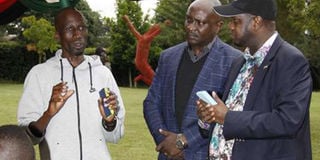Rio Olympics probe: Medical team 'poorly equipped and slow'

Marathon runner Wesley Korir (left) addresses Sports Cabinet Secretary Hassan Wario (right) and Principal Secretary in the ministry Joe Okudo at the High Performance Training Centre Kazi Mingi Farm in Eldoret Town on July 12, 2016. PHOTO | JARED NYATAYA |
What you need to know:
- Report proposes that funds be released early to buy supplies
- Qualified physios did not travel with athletes who lacked evacuation vehicles at the Games
- The International Olympic Committee (IOC) workbook has several medical guidelines.
- The ratio of doctors to athletes is one medic for every 50 athletes and one physiotherapist for every eight, but it varies on pharmacist, psychologist and nutritionist.
Team Kenya to the Rio Olympic Games’ health was at risk because of lack of proper medical care and evacuation vehicles in Brazil.
The Rio 2016 Probe Committee’s report indicates that most athletes used physiotherapists at the Olympic Village’s polyclinic rather than the one provided for them.
The absence of physiotherapists Victor Bargoria and Peter Nduhiu, who were suspended by Athletics Kenya aggravated the situation.
Some athletes said Bargoria and Nduhiu were the most qualified to handle them, but the two removed from the travelling list due to “internal politics” in the medical team.
The report said the athletes preferred the Olympic Village medical facility because the Kenyan medical team was slow in responding to their needs.
RELIED ON SHUTTLE BUSES
The head of the medical team, Dr Julius Ogeto, acknowledged some of the athletes’ complaints, saying that had no evacuation car and relied on the Games’ shuttle buses. The buses were only available every 30 minutes.
The probe committee recommended that Nock should, in future, select the medical team in consultation with the athletes and federations.
“We recommend that one of the vehicles given to Team Kenya be assigned for the exclusive use of the medical team to help them respond faster to athletes’ needs,” said the report.
The Team Kenya medical team had 26 doctors, physiotherapists, nutritionists, psychologists and pharmacists.
The International Olympic Committee (IOC) workbook has several medical guidelines. The ratio of doctors to athletes is one medic for every 50 athletes and one physiotherapist for every eight, but it varies on pharmacist, psychologist and nutritionist.
Going by the above ratios provided by the IOC, Team Kenya had four physiotherapists above the required number.
The report said that 150 athletes and officials were tested for the Zika Virus before and after the Rio Games and none of them tested positive for the mosquito-borne virus.
The report further said that even though the medical budget for Rio Games was Sh4.125 million for the purchase of medical supplies, the funds were only made available on July 20, 2016.
Considering that some of the medicines to be bought were sports specific, hence not easily found locally, the committee recommended that the funds be released at least two months before the Games.
It was also revealed that out of the cash, the medical team ended up spending only Sh1.9 million from the budget since Nock stores still had a consignment of medical supplies that remained from the 2015 African Games in Congo Brazzaville.





